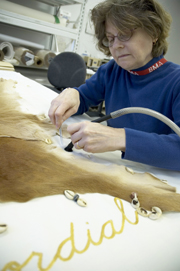Environmental Factors
The environmental factors that were considered when planning the new exhibition space included light exposure, temperature, relative humidity, and air quality.
Gallery Lighting
Most of the organic components of The Dinner Party (textiles, silk, lace, some of the dyes and colorants, fur, leather, wood, and bone) are susceptible to damage from light exposure while the ceramics, metals, and other inorganic materials are not. Exposure to light can cause textile fibers to degrade, resulting in brittle and weakened fabrics as well as visible yellowing. Silk and wool fibers are especially susceptible to degradation by light. Light exposure can also cause a color shift or fade many of the colors and dyes used in the textiles and embroidery threads. Note, for example, the once red fringe on the Susan B. Anthony runner now faded to dark pink.

Meters which measure ultraviolet radiation and visible light.
The damage caused by light exposure is cumulative and irreversible, but there are a number of ways in which the Museum can control and slow down the degradation of light-sensitive materials. As The Dinner Party is on long-term exhibition a number of safeguards were incorporated into the lighting of the work. Exhibition lighting is set at a low level of illumination and audience activation sensors installed in the gallery allow the light to remain off when there are no visitors, thus preventing unnecessary exposure. Through the use of special filters, all ultraviolet radiation has been eliminated from the light sources used in the installation. The creative lighting design maximizes the viewer’s visual perception while minimizing the deteriorating effect of light.
Temperature and Relavite Humidity
The climate within the Elizabeth A. Sackler Center for Feminist Art has been carefully considered to meet the needs of the varied elements and materials of The Dinner Party. High levels of humidity encourage insect infestation and the growth of mold, as well as increase the rate of fading. A low level of moisture often causes embrittlement in paper and textiles. Many of the organic materials (textiles, wood, paper, bone, leather, and skin) in The Dinner Party are “hygroscopic,” i.e., they will swell with increased moisture levels and shrink with decreased moisture. The expansion and contraction of “hygroscopic” materials in response to fluctuations of relative humidity is extremely damaging. A critical factor for preservation is maintaining the relative humidity within an acceptable range while preventing rapid increases or decreases.

Instruments which measure temperature and relative humidity.
Air Filtration
In addition to regular vacuuming of the textiles while they are on display, a “clean” room is critical to prevent a build-up of ingrained soiling of the fabrics when displaying textiles on long-term exhibition. Air pollution can have a detrimental effect on all the materials in The Dinner Party. Acidic pollutants aid in the hydrolysis (breakdown) of textiles, the corrosion of metals and ceramics, and the deterioration of leather. Air pollutants are generated not only by sources external to the Museum, but by internal sources as well. Particulate pollution such as soot, dust, fibers, pollen, and soil are airborne and are generated both outside and inside the Museum. External environmental pollution is mainly from sources of transportation and industry (sulfur dioxide and nitrogen dioxide). Within a Museum setting, various wood products, carpeting, flooring materials and adhesive can all emit harmful volatile pollutants such as formaldehyde, and nitric and acetic acids. Pollutants in the form of hair, clothing fibers, dander, and dust are also carried into the Museum by staff and visitors.

In designing the ideal environment, the construction materials used in The Dinner Party space were reviewed and if necessary, tested for harmful volatile components to ensure that little pollution was generated from inside the gallery space. Environmental engineers incorporated a number of precautions into the Museum’s air filtration system, which mitigate air pollution. All air coming from the outside passes through both gaseous and particulate filters. These filters remove at least 95% of the particulates and reduce gaseous pollutants to extremely low levels. Filtered air is introduced from the ceiling, while the air return vents are located in the outer galleries. This arrangement creates an unnoticeable airflow that discourages any particulates and gaseous pollutants generated within the space or introduced by gallery visitors from depositing on or near the artwork.
Without a doubt the exhibition environment plays a large role in the overall preservation of art, especially when on long-term display. Conservators, curators, architects, lighting designers, and engineers have worked together to create an environment ideally suited to the preservation and display needs of this monumental and complex work of art.
Read more about The Dinner Party’s preservation history.